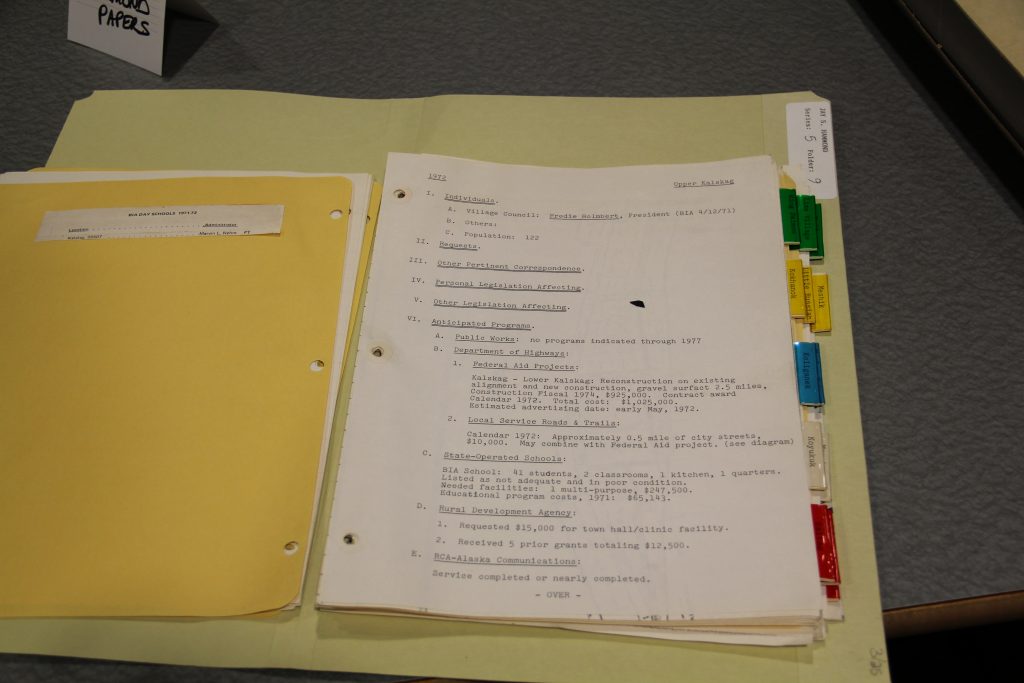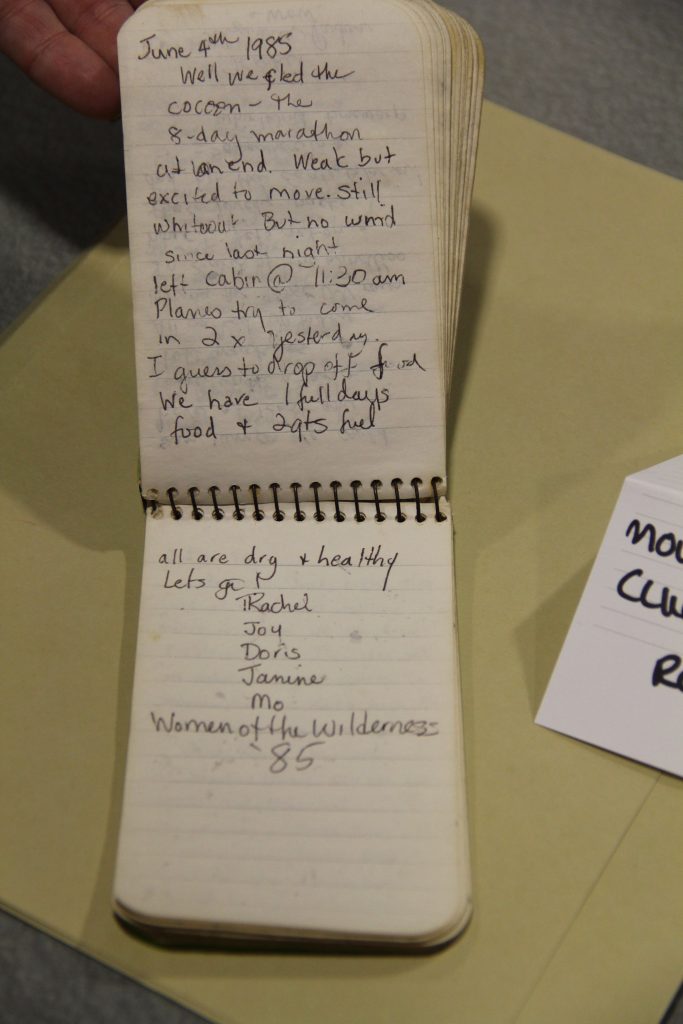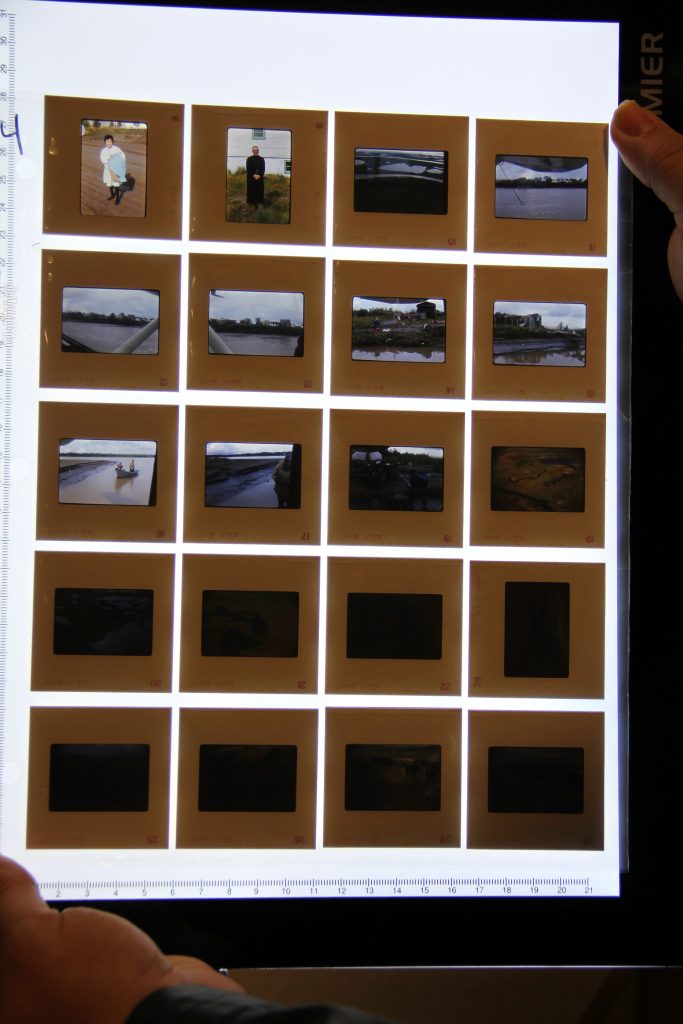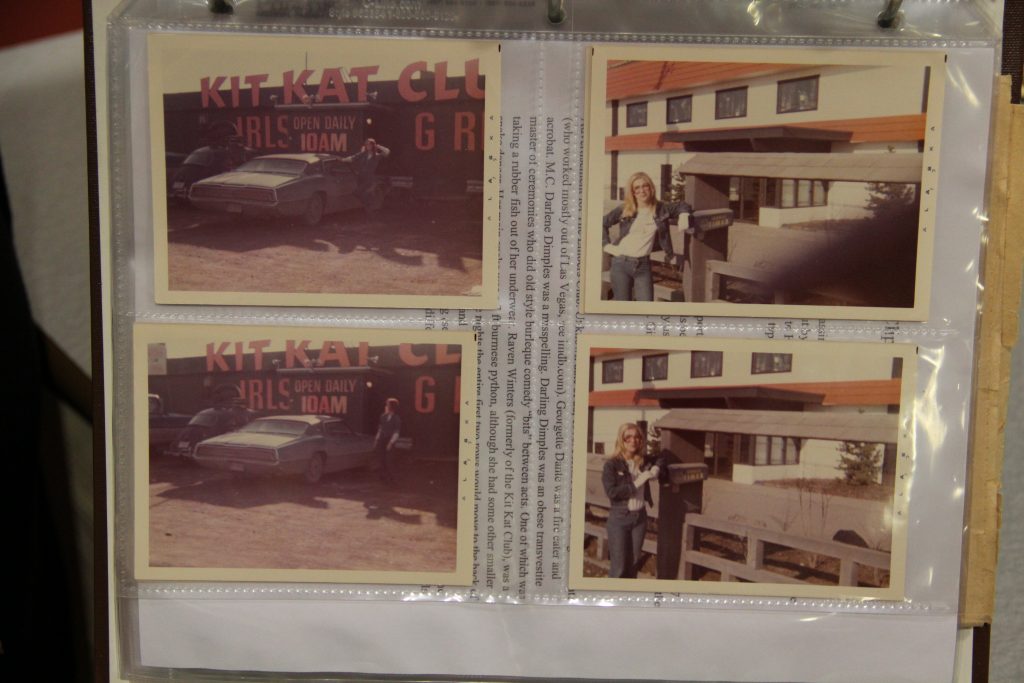We had an Open House on Wednesday afternoon to celebrate Archives Month and because we love just hanging out with our researchers, donors, colleagues, supporters: they’re friends! And we’re very thankful for them. We’re also thankful for Northwest Archivists, our regional professional association, for their financial support that allowed us to get invitations printed and buy treats to share at the event. What’s an open house without munchies? Thank you NWA! And thank you, everybody who attended.
We can’t do much about the food-type treats that you missed, but we can give you a glimpse at some of the collection materials we put on display. So, in no particular order, here’s a quick walk through the display space. The links in the collection names will take you to the guides to those collections if you’d like to read more about what the collections include. And our usual reminder: these are only a tiny fraction of the collections we have here for your research. You can see more about our collections through our main website where we have all of our collection guides posted.
In the meantime, enjoy a virtual walk through our exhibit. BYOC (bring your own cookies).

First up, from the Wildflower Garden Club records.

Their scrapbooks record their history with a level of artistic beauty we don’t often see in organizational records.

Next up, a ledger from the Charles Harvard papers. Mr. Harvard was a construction engineer and his collection includes a lot of computations for various aspects of his professional work. This is from when computer was a job title, not a piece of machinery.

The following is from the Rosalind Endter Koesting papers. Rosalind Endter moved to Anchorage in 1944 to work as a schoolteacher. Her collection mostly consists of letters, several of those are to her mom describing her life in the Anchorage of the day.

We’ll admit, this one hits the top of our share list because of the dog footprint: our pets seem to get everywhere, don’t they? But we also share it because of the content: this is a list of the explosives used in one month in the hard rock Independence Mine at Hatcher Pass. This document is part of the Alaska Pacific Consolidated Mining Company records we hold here at the Archives.

The Edwin F. Glenn papers. We shared some of the photos and a copy of the report from the 1898 Cook Inlet Army expedition, where Glenn led a team evaluating the likelihood of a southcentral Alaska route to gold producing areas. The photo prints in this collection are mostly cyanotypes: we particularly like to share those because many people are unfamiliar with photographic processes from the time and we occasionally get the question: “why did you scan this image and turn it blue?” We’ve also digitized posted all the photos and Glenn’s personal diary from the expedition online in the Alaska’s Digital Archives.

This is part of a speech file from the Johnny Ellis papers. Johnny ended his long term career in the Alaska Legislature in 2016.

This is part of a briefing book from the Jay Hammond papers. When Governor Hammond went to visit various locations in Alaska, his staff would prepare informational documents for him about the place he was going.

From the Alice Brown papers. Mrs. Brown was one of the founders of the Alaska Federation of Natives, and this particular folder of items comes from the 1968 AFN meeting. The CIRI Foundation funded the detailed processing of this collection (thanks TCF!) We haven’t run the stats quite yet, but we’re pretty sure the Alice Brown papers has been one of our most frequently used collections this year.

This photo album is from the Harold Stuart Smith papers. Mr. Smith was a staff sergeant in the army during WWII and served at Ft. Richardson. Most of the photos in his collection are more about non-military aspects of his life as is typical of most collections from servicemen as the military had prohibitions on photographing and sharing photographs of military facilities.These particular pages include recreational time: a Field Day at Ft. Rich on the left, and a baseball team on the right hand page.

This is the climber’s journal kept at the Whiteout Cabin on the Eklutna Traverse. It’s full of signatures and stories from mountain climbers and is part of the Mountaineering Club of Alaska records. Christine, one of our student workers, transcribed and digitized this journal and Veronica put it up on the Alaska’s Digital Archives if you want to take a closer look at it.

This small ledger from Herschel Island is from the Christian Theodore Pedersen papers. CT Pedersen was a whaler and fur trader and supplied trading posts along the Arctic coast.

Here’s a closer look inside that ledger. This is an account record for someone named Levine. It includes prices for the various groceries and supplies listed. This ledger dates from between 1925 and 1936.

This is one page of slides from the Dove Kull papers. Mrs. Kull worked for the State of Alaska as a social worker and traveled all over Alaska as part of her job. And she took photographs as she went. Unfortunately Mrs. Kull didn’t label a lot of her photos, so while she was great about photographing people all over the state, we and our researchers don’t always know who anybody in the photos might be! If you look through her guide and see any locations where you might recognize people that lived there between 1949 and 1982, talk to us! We’d be happy to work with you to get some of these images identified.

This is an example of a document that many people used to have in their houses: a guest book. This one comes from the Russ Dow papers. Russ and Rusty Dow are known as homesteaders in the Matanuska Valley area, but they also had a small cabin in Bootlegger Cove in Anchorage for several years too, and entertained there quite a bit.

This is a close-up view of one of the entries in that guest book. And this is Arlene speaking for myself now: I’m not often star-struck, I’ll admit. And looking at the list of people who visited the Dows is fascinating, but when I do get to show off this particular item, I tend to pause at this entry because: Dashiell Hammett! Even if the Dows got the title of the book they noted wrong, I am a long-time fan of the Thin Man movies (I marathon them regularly, and did so just two months ago) so I’m in a bit of celebrity awe here that the Dows got to meet the author of the Maltese Falcon and the Thin Man and and and… So while a lot of the items we put on display for the open house were things we all agreed on, this one was my selection alone.

This is an album page from the Lynn McConnell papers. Ms. McConnell worked as a showgirl in 1977 at several clubs in Anchorage, including the Kit Kat Club in south Anchorage.

Here’s a folder of papers from the Charles and Jack O’Neill papers (and I just spotted the spelling error on our display tag!) The O’Neills ran a store in McCarthy and the collection includes some of the shipping invoices for the goods they sold in their store.

Here’s a closer look at that freight bill on top. It includes the 6 sacks of potatoes, 1 box of bananas, 1 box of tomatoes, and 1 box of lettuce and celery shipped from Seattle to Cordova in March 1939 where it was then turned over to the Cordova Air Service for the delivery to McCarthy.

This scrapbook represents one of our more recent additions to the collections here, the Rage City Rollergirls records. Sometimes people forget that archives aren’t just about the old! We’re about preserving and making accessible unique documentation and it doesn’t have to be over 50 years old to qualify for that. Along with the scrapbook, we put one of their application packets on display as well.

We have a lot of collections from tourists who visited Alaska including the Cornelia and Renier Kessels scrapbook. What some people might not know is that Alaska was a huge tourist destination even back in the 1930s. This album/scrapbook came from a couple who took the SS Rupert to Alaska (they even lifted their stateroom key and put it in their scrapbook: good thing all the tourists didn’t do that or the steamship companies would have been spending a ton on key replacement!)

The C L Andrews photographs were already out in the research room because Arlene has been rehousing all the glass lantern slides for storage. The wood and metal boxes in the back of the shot? That’s how they came in. The wood box was actually built for housing these, the metal box not, but we need to get them into better archival housing. Most archives that collect Alaska-related materials probably have C L Andrews collections. Among other things, he photographed the places he visited in Alaska and then produced a lot of these slides and sold them commercially. Our collection of C L Andrews is a mix of glass lantern slides and negatives, many of which are nitrate stock so we’re being very careful with those. We’re getting his collection digitized and online. We’ve already put 31 of the images up on the Alaska’s Digital Archives. In the case of the nitrate stock, the high resolution digital surrogate will end up being the preservation copy because of the limited life expectancy of the nitrate. We didn’t put any of the nitrate on display, we’ll admit. That just wouldn’t have been a good choice.

Here’s a slightly closer look at some of those glass lantern slides from C L Andrews on the light table on display.

Lastly, we also put out a very small selection of books from the Consortium Library’s Rare Books collection which lives in our space since we can provide the security these books require. The tan colored larger book in the middle is “The prevention and cure of disease; a practical treatise on the nursing and home treatment of the sick” written by George Henry Napheys and published in Springfield, Massachusetts by W.J. Holland and Company in 1875. It was the source of the recipes for the Convalescent’s Banquet we held that started all our annual food from the archives potlucks back in 2014. (for more information about that specific potluck, check out our blog post entitled Chez Bland.)



